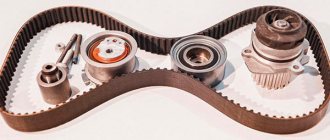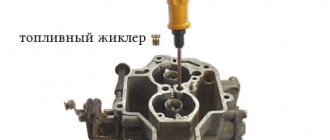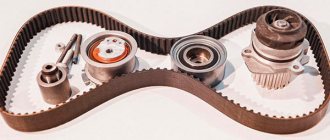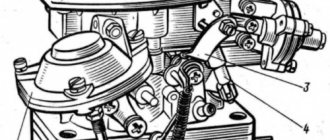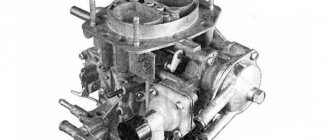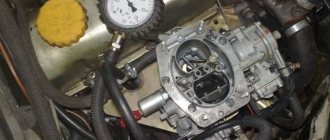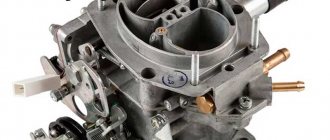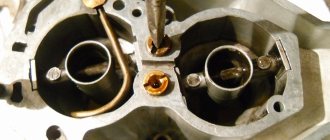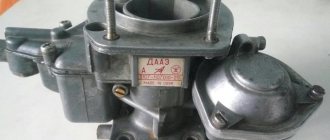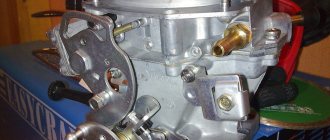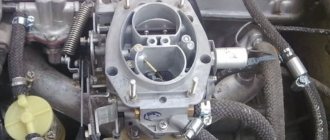What are jets in a carburetor?
Carburetor jets are calibrated holes inside the carburetor. Such elements can be made of various materials and differ in the diameter of the working hole.
Jets can be installed inside the carburetor cavity in various ways. Some elements are pressed inside a hole of a larger diameter. Thanks to this arrangement, it is possible to ensure greater resistance of products to increased levels of vibration. The disadvantage of this type of element is the more complex maintenance and repair process.
The jets may have threads on the outer surface, which allows these parts to be easily screwed into the carburetor body. The advantage of this design is that it simplifies repairs, including replacing faulty elements with new products.
What are the jets responsible for?
Jets are needed to supply fuel in a certain ratio. The carburetor has a large number of micro-channels through which air can also be supplied, which is necessary to fill various cavities when the fuel level in them decreases, as well as when preparing the fuel mixture.
Several jets are installed in the carburetor. The idle jet most often needs cleaning if low-quality gasoline is used or the fuel filter is not changed on time. The fuel consumption and engine response will depend on the correct adjustment of the jets, and if the jets are incorrectly selected with the wrong hole diameter, the engine may not start due to flooded spark plugs.
Given the importance of these elements, replacement products should be selected only taking into account the catalog number of the main part. For example, if Solex jets are needed for replacement, then you should buy and install only products for this type of carburetor. It is also necessary to take into account the designations from the set of numbers following the name of the dosing system (Solex 21073, Solex 21083, etc.).
Which jets are better
If it is possible to purchase products made of brass, then you should give preference to products made from this copper alloy. Brass is resistant to aggressive environments, so products made from it do not rust in the carburetor throughout its entire service life. Automotive fuel may contain a large number of additives that can have a negative effect on other types of materials. For this reason, you should not use homemade jets or try to replace these parts with any tubes that match the outer diameter.
Original carburetor jets are better than those purchased for replacement in various repair kits. For this reason, if it becomes necessary to replace one part, you should not install all elements of this type.
Carburetor malfunctions DaAZ 2107 1107010
A mixer is a complex device containing many thin jets, channels, and small parts. A small grain of sand inside the calibrated hole is enough to disrupt the usual rhythm of operation of the unit. Signs of problems are clearly visible. The main reasons are lack of air, gasoline, and violations in the creation of a combustible mixture. Timely cleaning, flushing, carburetor adjustment, maintenance, and replacement of the air filter will eliminate troubles during the trip. A brief overview of the most common breakdowns.
- The car starts, but idling is unstable.
- Fuel consumption has increased noticeably.
- It is impossible to accelerate the car; the idle speed remains stable.
- There are “failures” when trying to move away.
- There are difficulties with cold starting.
- Complications of hot starting.
- Idle speed is too high.
- The carburetor fires.
- No fuel is supplied.
- The outside of the carburetor is wet, there are drops of gasoline on the body.
- Random, non-systemic outages.
The listed symptoms do not clearly indicate disassembly or repair of the carburetor. You should first make sure that adjacent components and mechanisms are in good working order. For example, an untuned ignition or a worn piston group will not allow you to get a clear picture of what is happening. Possible sins of the mixer, with the exception of wear of the basic parts, can actually be eliminated in the home garage.
How to properly clean carburetor jets from plaque and dirt
If, while cleaning the jets, the basic standards for carrying out such an operation are violated, then significant deviations in engine operation are possible due to changes in the fuel dosage. The air jets of the Solex carburetor also need to be properly freed from dust contamination. It is also important to clean the lambda probe in a timely manner.
When setting up the carburetor metering system, superficial cleaning of the jets can be carried out. This method of removing contaminants will not take much time, but its use is only possible if there are relatively minor problems with the performance of this unit.
In case of significant contamination, a thorough cleaning of the jets is required, and if the performance of the products cannot be restored, then a new part is installed.
Surface cleaning of jets
Surface cleaning of jets can be carried out using special aerosols. A can of solvent will be inexpensive and can be easily found in specialized auto parts stores. The product has a long tube for supplying the active substance, which allows for precise spraying of liquid in the most economical way. The procedure for cleaning the jets of a Solex 21083 carburetor or other similar models is carried out in the following sequence:
- The air intake or air filter housing is removed (depending on the car model).
- The air and fuel jets of the main metering system are unscrewed (you need to remember the markings of the jets in order to correctly install them in place).
- The idle speed solenoid valve is removed.
- The aerosol is fed into the holes cleared of parts.
- Air and fuel jets are installed.
- The fuel choke lever is pulled out.
- The engine starts.
- A running engine warms up at idle and medium speeds.
- The engine turns off.
- The solenoid valve and air duct or filter housing are installed.
After connecting all the elements, start the engine again and check its operation in various modes.
Thorough cleaning of jets
If superficial cleaning of the jets did not bring a positive effect or the performance of the carburetor was restored only for a short time, then more thorough work will need to be done. In order to qualitatively restore the throughput of small parts, you will need to remove the carburetor from the car. This is not difficult to do, but first you need to disconnect the following elements:
- Air duct.
- Throttle rod or cable of the gas pedal.
- Control cable for the fuel suction system.
- Fuel hose.
- Solenoid valve wire.
Next, remove the carburetor from the intake pipe. In the carburetor, unscrew all the screws holding the lower part of the product. The device is disassembled into 2 halves. All internal jets are unscrewed and washed in acetone, and also blown with compressed air. In order not to confuse parts of similar size, they can be placed in plastic containers with inscriptions. The internal channels and fuel chamber are also thoroughly washed with solvent.
When the jets are dry, they are installed in place, the carburetor is assembled and installed on the inlet pipe. After connecting the controls, air supply and power, the engine is started and its operation is checked in various modes.
Which carburetor is better to put on a VAZ 2107
Starting from the first models, Tolyatti cars are equipped with devices from domestic automakers. The Dimitrovgrad Automotive Aggregate Plant in the Ulyanovsk region produces mixers under license from the French company Weber.
Key parameters:
- maximum simplicity of design facilitates service operations;
- high dynamic qualities, the ability to reach a speed of 100 km/h in a minimum period of time;
- economical fuel consumption;
- satisfaction of environmental conditions.
The initial developments of automakers in the seventies of the last century did not ensure the fulfillment of the last two points. Modern, improved brands designed for classic VAZ 2105 - 2107 cars consume fuel 20 - 25 percent less than similar predecessors while maintaining other positive properties. Environmental characteristics earned the products the name Ozone. The price for four positive indicators is increased requirements for the purity of petroleum products being refilled and periodic cleaning.
Car enthusiasts who dream of increasing the speed capabilities of the iron horse should pay attention to the DAAZ 21053. Licensed samples were developed by a company from France, Solex. Low prevalence has caused insufficient popularity and difficulty in acquisition. Radical differences in engineering solutions from previous systems reduce 0.5 - 0.7 liters of filled fluid per reference driving distance.
There are three types of DAAZ 2107 carburetors used with VAZ-2103, VAZ-2106 power units of different production periods:
- 1107010, installed on early sedans;
- 1107010-10, updated, modified version;
- 1107010-20, installed on engines equipped with a vacuum ignition timing corrector built into the chopper-distributor block.
The principle of spark formation for “sevens” has undergone changes. An electronic switch, built on a bipolar transistor in a sealed, replaceable module, replaced mechanical contacts. The energy of the spark charge has increased, the reliability of ignition in cold weather has increased, and the cleanup of burnout has disappeared.
VAZ 2107 carburetor design
Carburetor bodies are made of zinc and aluminum alloys using injection molding. The result is light, durable parts. Both metals instantly oxidize when exposed to oxygen. Treatment of cast products with a solution of chromic acid allows you to create the thinnest protective film on the surfaces. Chromate coatings are designed to protect floats and chamber walls from corrosion.
Design of the VAZ 2107 carburetor: 1 - driving lever, drive of the second chamber; 2 - adjusting screw for the amount of idle mixture; 3 — carburetor heating block; 4 — engine crankcase ventilation pipe; 5 — accelerator pump drive lever; 6 - solenoid shut-off valve; 7 — air damper lever; 8 — carburetor cover; 9 — bolt for fastening the liquid chamber; 10—liquid chamber body; 11 — carburetor body; 12 - throttle lever of the second chamber; 13 — sector of the throttle valve control lever; A - marks for correct installation of the bimetallic spring of the starting device.
To avoid destruction of protective coatings and to remove foreign deposits and contamination, it is prohibited to use abrasive materials. Scratches caused by moisture will cause the appearance of oxide crystals that clog the clearances of the jets.
Short description
It is mounted with the lower part on the four studs of the intake manifold. The top side meets the air filter. The middle includes the main components.
Two chambers with dampers create fuel - an air emulsion. The opening of the first is controlled by the driver via the accelerator cable, the right pedal in the car interior. A pneumatic drive controls the operation of the second. Both valves are inactive when the gas pedal is not pressed. An air curtain with manual control from the passenger compartment - a suction - will help change the ratio of the mixture components. There is a pin on the front panel and a flap on the cap. The extended position corresponds to complete closure. Recessed - slightly opens air access.
Idle and cold start systems create conditions for a confident start of a cold engine and operation at minimum speed.
A set of mechanisms designed to power the power unit at high speeds:
- Econostat eliminates excessive fuel compensation at maximum power;
- accelerator pump;
- second camera.
The main metering system supplies the necessary power for two-thirds of the power, but cannot cope with supplying a sufficient amount of fuel at high vehicle speeds. Pumping of additional portions of fuel is connected, enriching the mixture.
The float chamber is balanced. A constant level of fuel fluid allows you to change the crankshaft speed over a wide range without stopping stable operation.
The passage of gasoline and air is determined by the cross-section of the corresponding passage holes.
What jets are used in the VAZ 2107 carburetor
| Carburetor markings | Main system fuel jet | Main system air jet | Idle fuel jet | Idle air jet | Accelerator pump jet | |||||
| I Kam. | II Kam. | I Kam. | II Kam. | I Kam. | II Kam. | I Kam. | II Kam. | fuel | bypass | |
| 2101-1107010 | 135 | 135 | 170 | 190 | 45 | 60 | 180 | 70 | 40 | 40 |
| 2101-1107010-02 | 130 | 130 | 150 | 190 | 50 | 45 | 170 | 170 | 40 | 40 |
| 2101-1107010-03: 2101-1107010-30 | 130 | 130 | 150 | 200 | 45 | 60 | 170 | 70 | 40 | 40 |
| 2103-1107010 | 135 | 140 | 170 | 190 | 50 | 80 | 170 | 70 | 50 | 40 |
| 2103-1107010-01: 2106-1107010 | 130 | 140 | 150 | 150 | 45 | 60 | 170 | 70 | 40 | 40 |
| 2105-1107010-10 | 109 | 162 | 170 | 170 | 50 | 60 | 170 | 70 | 40 | 40 |
| 2105-1107010: 2105-1107010; 2105-1107010-20 | 107 | 162 | 170 | 170 | 50 | 60 | 170 | 70 | 40 | 40 |
| 2107-1107010: 2107-1107010-20 | 112 | 150 | 150 | 150 | 50 | 60 | 170 | 70 | 40 | 40 |
| 2107-1107010-10 | 125 | 150 | 190 | 150 | 50 | 60 | 170 | 70 | 40 | 40 |
| 2108-1107010 | 97;5 | 97;5 | 165 | 125 | 42+/-3 | 50 | 170 | 120 | 35/40 | — |
Replacing carburetor jets
If earlier during operation of the machine the rules for cleaning the jets were grossly violated, then the parts will need to be replaced. For example, if the owner of a car used metal wire or needles to clear calibrated holes from contamination, the diameter of the product could increase. If such a problem occurs on the fuel nozzle, then the engine will be filled with gasoline, and on the air nozzle, the car will run on a lean mixture. Both situations will not allow you to comfortably operate the vehicle, so you will have to replace damaged parts.
Sometimes, installation of a new carburetor jet is required as a result of the loss of an element during cleaning. For example, if a powerful compressor unit was used to blow through the product, the part may fly out a considerable distance if it was not properly fixed during the work.
To replace the jets you will need to buy a new repair kit. Then you should disassemble the carburetor, as when performing a thorough cleaning, unscrew the old ones and install new elements.
Options for modification and selection of jets on Solex carburetors
The Solex 21083 carburetor jets can be modified to change the dynamic and economic performance of the engine. A feature of such work is the need to change only fuel or only air dosing elements. If you need to increase power, then it is enough to slightly increase the diameter of the fuel elements; to increase engine efficiency, a similar operation is carried out with air jets.
Increasing the diameter by drilling is possible, but given the large error when performing such an operation, it is recommended to select a part with the required size from the jet table.
Solex 21083 carburetor jet table
You should study the jet table at the very beginning of work to improve the car’s fuel system. For the DAAZ Solex 21083 carburetor, the diameter and catalog number of the fuel jets will be as follows.
| Carburetor models | 1st camera | 2nd camera |
| 21083-1107010 | 95 | 97,5 |
| 21083-1107010-31 | 95 | 100 |
| 21083-1107010-35 | 95 | 100 |
| 21083-1107010-62 | 80 | 100 |
The following products can be used as air jets when selecting a new part.
| Carburetor models | 1st camera | 2nd camera |
| 21083-1107010 | 155 | 125 |
| 21083-1107010-31 | 155 | 125 |
| 21083-1107010-35 | 150 | 125 |
| 21083-1107010-62 | 165 | 125 |
Fuel jets xx (idle):
| Carburetor models | 1st camera | 2nd camera |
| 21083-1107010 | 39-44 | — |
| 21083-1107010-31 | 38-44 | — |
| 21083-1107010-35 | 38-44 | — |
| 21083-1107010-62 | 50 | — |
Knowing the catalog number of the carburetor, it is easy to compare the parts with each other and choose the most suitable jet for tuning.
What is the difference between modifications 21081 and 21083
The modifications of the Solex 21081 and Solex 21083 carburetors are almost identical. In devices for preparing the working mixture, only the diameters of the nozzles and the operating principle of the fuel suction system differ slightly. The Solex 21081 carburetor has a semi-automatic device for starting the engine, while the Solex 21083 has a mechanical device controlled by a button.
The differences in the throughput of the jets are due to the difference in the working volumes of the engines 21081 and 21083.
Jet table for comparing calibration data for Solex 21081 and 21083 carburetors
The table shows calibration data for Solex 21081 and Solex 21083 carburetors.
| Options | 21081-1107010 | 21083-1107010 | ||
| First camera | Second camera | First camera | Second camera | |
| Diffuser diameter, mm | 21 | 23 | 21 | 23 |
| Fuel jet GDS | 95 | 97.5 | 95 | 97.5 |
| Air jet GDS | 165 | 135 | 155 | 125 |
| Emulsion tube | 23 | ZC | 23 | ZC |
| Fuel jet CXX | 39-44 | — | 39-44 | — |
| Air jet CXX | 170 | — | 170 | — |
| Fuel nozzle of the transition system of the 2nd chamber | — | 50 | — | 50 |
| Air jet of the transition system of the 2nd chamber | — | 120 | — | 120 |
| Econostat fuel jet | — | 70 | — | |
| Economizer fuel jet | 40 | — | 40 | — |
| Acceleration pump nozzle | 35 | 40 | 35 | 40 |
Idle systems
Fuel enters the idle system and the transition system from the gas station. The idle system of the DAAZ-4178 and K-126 carburetors is with throttle spray. It cannot provide good mixture formation, since a jet of fuel-air emulsion is fed into an air stream flowing at a low speed. In this case, the mixture is distributed unevenly among the cylinders, which increases CO and CH emissions and makes idle adjustment more difficult.
In K-131 carburetors, the autonomous idle system is a miniature carburetor through which the main part of the air charge passes. The throttle valve is almost completely closed at this time. The minimum gap is needed only to ensure that the damper does not “bite” in the closed position. The fuel is supplied to the idle system atomizer, in which the air flow moves at high speeds. This ensures almost perfect fuel atomization and uniform distribution of the mixture across the cylinders (in composition).
The EPH valve control system for K-131 carburetors is similar to the same system on the K-151, and everything said in the last issue is true for it.
In the operation of any carburetors, the largest number of failures is due to disturbances in the idle system. This is not surprising - after all, its fuel nozzle has a too small cross-section (0.45–0.60 mm). Therefore, if the idle speed “disappears”, then it is the first candidate for purging. True, before disassembling the carburetor, it makes sense to carry out simple diagnostics (for K-131, see No. 12, 2004).
Adjusting the Solex 21083 carburetor
Cleaning the internal parts of the carburetor and the correct selection of products according to the diameter of the nozzle holes does not yet guarantee stable engine operation. Setting up the carburetor is a mandatory procedure after performing any type of work related to disassembling the product. The procedure for adjusting the Solex 21083 carburetor consists of setting the optimal fuel level in the float chamber, the idle speed and tightening the mixture quality adjustment screw.
Fuel level in the Solex 21083 carburetor
To adjust the fuel level in the float chamber, you will need to disassemble the carburetor, so it is advisable to combine this procedure with a complete cleaning of the jets (you do not need to remove the device from the inlet pipe, but only dismantle the upper part of the product). The float chamber is filled automatically. The needle valve that closes the fuel hole is mechanically connected to a float, which lowers when the gasoline level decreases. To ensure that there is always a sufficient level of fuel in the float chamber to ensure non-stop operation of the engine, as well as to eliminate the possibility of overflow, the opening moment of the valve is set by adjusting the position of the float relative to the body of the top cover of the Solex carburetor.
To perform adjustment work, you will need to prepare the following tools:
- A small piece of wire (diameter 1 mm).
- Calipers.
- Ruler.
If the carburetor is not disassembled, then you should remove the top cover of the product by first unscrewing 5 screws. The part separated from the main body should be placed on a flat, hard surface with the floats facing up.
At the next stage, the parallelism of the floats relative to the side imprint on the gasket is established. If the lines diverge, then carefully bend the hollow element so that along the entire length of the product there is an equal distance between the control strip and the float.
Set a 1 mm gap between the floats and the top cover. For this purpose, it is necessary to place a control wire between the hollow product and the gasket of the carburetor top cover. If the distance is greater or less, then the correct interval should be set. The easiest way to set the gap is the following method:
- Extend the depth gauge of the caliper to 34 mm.
- Place the depth gauge on the carburetor top cover gasket parallel to the float.
- Bend the lever or tongue on which the needle valve rests so that the top of the float is at a distance of 34 mm from the top carburetor cover.
Using a ruler, you should also check the maximum lift relative to the top cover (or the lowering of the float when this part is in normal operation). For this purpose, it is enough to install the measuring tool parallel to the float. The maximum distance between the float and the top cover should be 25 mm.
After performing adjustment work for one float, the operation is repeated on the second element. Then the carburetor is assembled and the operation of this part is checked. If, after correct adjustment, the engine is filled with fuel again, you should check the functionality of the needle valve. If this element does not block the fuel nozzle, it should be replaced.
Basic operating modes of the carburetor
When the carburetor jets of the VAZ 2109 - 2108 are replaced or cleaned of contaminants, the idle speed will need to be adjusted. In order for air to enter the combustion chamber in the required quantity to prepare the fuel mixture, you should adjust the damper screw to set its opening gap to 2.5 mm (you can also use a wire or drill of the appropriate diameter, which is placed between the moving element and the carburetor body).
Adjusting the idle speed of a VAZ 2108 or 2109 is carried out as follows:
- The engine warms up to a temperature of 90˚C.
- The fuel choke valve opens completely.
- By rotating the “quantity” screw, engine operation is set at a frequency of 750 - 800 rpm (checked with a tachometer).
If it is not possible to set the idle speed within the specified limits, then you should enrich or lean the mixture using the “quality” screw. To set accurate values, you need to use the “quantity” screw to increase the speed to 900 rpm, and by screwing in the “quality” screw, reduce this figure to 800 rpm.
When performing work on setting up the Solex 21083 carburetor, you should also check the serviceability of the accelerator pump, which supplies an additional portion of fuel to the carburetor when the throttle valve is sharply opened. You should also make sure that the shutter of the second chamber moves freely when the first shutter is fully open. Only with the correct settings of these elements can you achieve stable operation of the carburetor at idle and excellent dynamic performance when accelerating the car.
Comments
Victor Vdovin replied on Tue, 04/26/2016 — 07:31 Permanent link (Permalink)
K-151 carburetors are most widely used on light trucks from the Ulyanovsk and Gorky plants. An article was devoted to them in the last issue. However, there are others - the single-chamber K-131 and the two-chamber K-126G. Both are produced by OJSC Fuel Systems (PEKAR) in St. Petersburg. In recent years, for engines with a working volume of 2.3 to 2.9 liters, the Dimitrovgrad Automotive Aggregate Plant (DAAZ) has begun production of two-chamber DAAZ-4178 carburetors of two modifications. They were developed on the basis of the DAAZ-2111 carburetor of the Oka car. It would seem, what do such different cars and engines as Oka and UAZ have in common? They are united by increased requirements for the strength of the equipment due to the high level of engine vibration.
Two-barrel carburetors for small trucks and cars, like the K-151, have sequential opening of the throttle valves. Now let's look at the design features of carburetors in more detail.
